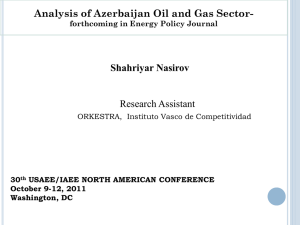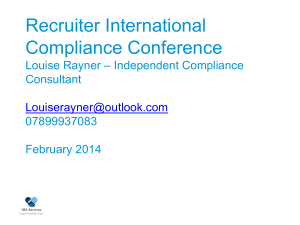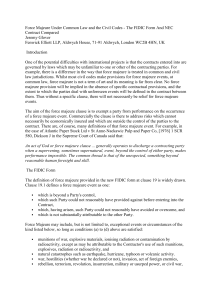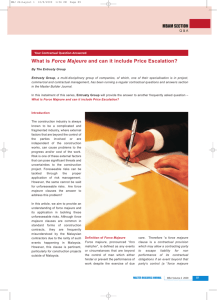Final PPT Risk Allocation
advertisement
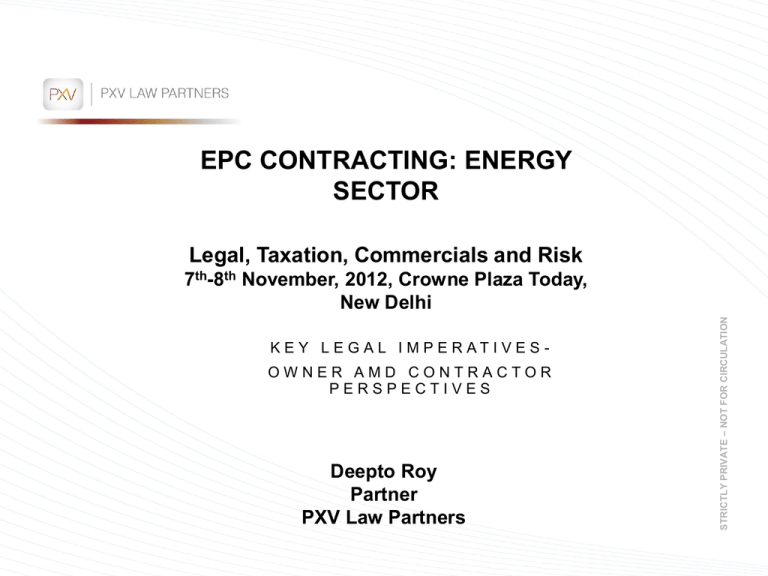
EPC CONTRACTING: ENERGY SECTOR Legal, Taxation, Commercials and Risk K E Y L E G A L I M P E R AT I V E S OWNER AMD CONTRACTOR PERSPECTIVES Deepto Roy Partner PXV Law Partners STRICTLY PRIVATE – NOT FOR CIRCULATION 7th-8th November, 2012, Crowne Plaza Today, New Delhi “It is not enough to attain a degree of precision which a person reading in good faith can understand. It is necessary to attain, if possible, a degree of precision which a person reading in bad faith, cannot misunderstand” - Justice Stephen, quoted in “Practical Legislation” By Long Thring (1902). 2 INTRODUCTION • EPC Contracts- Risk Analysis and Allocation • Owner and Contractor Considerations in EPC Contracts • Key focus areas Risk and Title: pass through issues Liquidated Damages Limitation of Liability Force Majeure Suspension, delay and termination of contract 3 CONTRACTUAL MATRIX IN AN INFRASTRUCTURE PROJECT Sponsor Support Sponsors Shareholders Agreement Lenders Loan Agreement Security Documents Government Government Support Implementation Agreement Fuel Supply Contract Engineering, Procurement, Construction Contracts O & M Contract Offtake Contract Offtaker Fuel Suppliers Operator 4 EPC Contractors RISK MATRIX Country and Regulatory Risks Specific Project Risks Development Risk • • • • • Political Risk including expropriation risk Country Legal infrastructure Risk including regulatory risk and legal enforcement risk Physical infrastructure risk Foreign Exchange Risk Devaluation Risk • • • Planning Delay Risk Approval Risk Land Acquisition Risk Construction Risk • • • • • • • • 5 Design Risk Delay Risk Specifications Risk Delay Risk Completion Risk Cost Overrun Risk • Material Cost • Labour Cost • Equipment Cost Force Majeure Risk Compliance Risk Operation Risk • • • • • • • • • Technical Risk Demand Risk Input Risk Delay Risk Performance shortfall Approval Risk Land Acquisition Risk Cost Escalation Risk Management Risk Compliance Risk CONTRACTUAL MECHANISMS TO ADDRESS RISK • Fixed Price, Lump-sum, “Turn-key” Contracts with limited provisions in relation to price escalation • Contractually prohibiting changes in scope of works without variation/ change orders • “Time is of essence”- strict compliance of timelines and limited grounds for claiming an extension of time • Strict performance targets, usually for project output, efficiency and reliability, which the facility must meet • Testing and rejection rights • Liquidated damages for delay and underperformance • Independent payment security mechanisms • Extended warranties (defects liability, latent defects liability) • Passage of risk and title 6 KEY OBJECTIVES OF THE OWNER AND THE CONTRACTOR Owner’s Objectives Contractor’s Objectives • • Rational allocation of risk • Pass-through of taxes and other external costs • Extension of time and increased costs for delay as a result of circumstances beyond the contractor’s control Certainty of costs with limited escalation • “Back-to back” with project contracts • Adherence to timelines and time for completion • Compliance with specifications and warranties • Force Majeure protection • Pass-through of compliance risk • Timely payment • Interface with other contractors • Certainty of total outside liability • Single point of contact and responsibility 7 LIQUIDATED DAMAGES • Liquidated damages (LDs) are pre-quantified damages which the parties to a contract agree shall be payable in case of breach of such a contract. • Provides certainty where damages are difficult to ascertain, for example in case of delay • Typically subject to aggregate caps • Acts in two ways, provides certainty to the claimant of the amount that can be claimed and also provides a limitation to the liability of the contractor • Legal Basis- Section 74 of the Indian Contract Act, 1956 - in case a contract is breached by a defaulting party and such a contract provides for a specific sum to be paid in case of such a breach, then the non-defaulting party is entitled to receive reasonable compensation not exceeding the amount so specified • Typically for delay and underperformance, but can sometimes address specific issues, e.g., EHS liability • Delay Liquidated Damages (DLDs) are usually expressed as a rate per day which represents the estimated extra costs incurred (financing charges, supervision fees etc.) and losses suffered (revenue foregone) for each day of delay • Performance Liquidated Damages (PLDs) are damage that the facility will suffer over its life if a specified technical characteristic is not met. 8 … LIQUIDATED DAMAGES • Key legal issues in relation to the LDs are: • No need to prove the quantum of damages if the damages have been specified in the contract, but some loss needs to be proved. Union of India v. Raman Iron Foundry, (1974) 2 SCC 231). • Cannot be in the nature of a penalty • The damages stipulated would be a cap, i.e. a court would not award damages in excess of the amount specified - Fateh Chand v. Balkishan Das (AIR 1963 SC 1405) Supreme Court in the case Oil & Natural Gas Corporation Ltd vs. Saw Pipes Ltd (AIR 2003 SC 2629) has laid down the following principles to be considered while awarding damages: The terms of the contract are required to be considered before arriving at a conclusion on whether a party claiming damages is entitled to the same; If the terms stipulating liquidated damages are clear and unambiguous, the party who has committed the breach is required to pay such compensation, unless it is proved that such estimate of damages/compensation is unreasonable or is by way of penalty. In every case of breach of contract, person aggrieved by the breach is not required to prove actual loss or damage suffered by him. The Court is competent to award reasonable compensation in case of breach if the non-defaulting party proves that it has suffered some loss. In some contracts, it is not possible for the Court to assess the actual loss arising from breach and the Court can award damages, as stipulated by the parties, if such damages are a genuine pre-estimate of the losses that may be incurred. 9 … LIQUIDATED DAMAGES • Some drafting issues in relation to liquidated damages clauses • Performance LDs and Delay LDs should be drafted separately • “Prevention Clause”- in case delay is as a result of failure by the Owner or another of the contractors employed by the Owner. • Treatment of “Concurrent Delays”, i.e. where different causes of the delay overlap, some by the Owner and some by the Contractor • Exclusive Remedy Clause • If the contract contains an exclusive remedy clause, then the Contractor will only be liable to liquidated damages for the specific events and not for any other damages • Owner does not have a right to claim damages other than LDs- risk that certain events will be excluded from liability • If no exclusive remedies clause is there, Owner is free to seek damages in law for other breaches • Failsafe Clause- in case the liquidated damages clause is held to be unenforceable 10 LIMITATION OF LIABILITY • The clause helps in identifying and limiting the liability of the Contractor in relation to the works done under the contract • Covers three main aspects Nature of liability, i.e. the remedies that the Owner will have against the Contractor, such as damages, indemnity or replacement of goods or reconstruction of portions of the infrastructure in case the Contractor is in breach of the Contract. Extent of liability i.e. the maximum aggregate liability that the Contractor may incur. Duration i.e. the period during which the Contractor may be held liable. The Contract may provide for different time period for which the Contractor will be liable for different aspects of the project. For example, a defect liability period may be 1 year from the date of completion of contract, whereas liability latent defects may extend up to 3 to 5 years. • Sitaram Brindavan v Chiranjilal Brinjlal, AIR 1958 Bom 291. In law, parties have the right, by contract, to exclude certain remedies and liabilities, including the right to claim damages • Overall liability is almost always capped at 100% of the Contract price • DLDs and PLDs are individually capped as well as capped in aggregate • Consequential and indirect damages are excluded- Hadley v Baxendale, (1854) 9 Exch 341. • Specific exceptions for gross negligence or fraud, or incidents such as death or injury. • Limitation on liability clauses are always strictly interpreted and any limitation and exclusion agreed between the parties must be clearly specified for them to be excluded 11 FORCE MAJEURE • 12 One of the most important clauses in the contract- typically receives little drafting attention An event “that can be neither anticipated nor controlled” and is not “reasonably foreseeable” The Indian Supreme Court has noted that “force majeure” is not a mere French version of the Latin expression “vis major”. It is a term of wider import and encompasses situation which may not qualify as “vis major”. The Supreme Court has held that “where reference is made to "force majeure", the intention is to save the performing party from the consequences of anything over which he has no control. This is the widest meaning that can be given to "force majeure”. [Dhanrajamal Gobindram v. Shamji Kalidas, 1961 SCR (3)1020] Force Majeure is a civil law concept and the only common law analogy, is the doctrine of frustration (Section 56 of the Indian Contract Act, 1956). However, since the scope and applicability of doctrine of frustration is significantly different, parties contractually agree on a force majeure clause. “Sphere of influence” concept Force Majeure of Subcontractors- included or excluded? Impact on the “Critical Path” WHAT DOES NOT CONSTITUTE FORCE MAJEURE Unless expressly specified by the parties, the following have been held to not qualify as events of force majeure: Events which merely increase the cost of performance of the contract (Amuruvi Perumal v. Sabapathi Pillai, AIR 1962 Mad 132) An order of restraint passed by a court in proceedings brought before it by a party to the contract does not amount to an act of the government and has been held to not constitute event of force majeure [Interore Fertichem Resources SA v. MMTC of India Limited, Delhi High Court, judgment dated 10 October 2007] Changes in law that make the performance of the contract more onerous commercially (but not impossible to perform) than what is contemplated at the time of entering into the contract (Naihati Jute Mills Ltd. v. Khyaliram Jagannath, AIR 1968 SC 522) Delay by a supplier, who is affected by an event of force majeure unless affected party can prove that it could not have procured the goods form another supplier (Shri M.L. Narang v. Union of India, Delhi High Court, judgment dated 15 December 2003) Bad weather conditions, which usually interrupt work (Matsoukis Vs Priestman & Co, 1915 1 KB 681) 13 KEY ISSUES IN THE FORCE MAJEURE CLAUSE Issues Owner’s Perspective Contractor’s Perspective To minimise instances where a force majeure clause may be invoked, expressly state events which are foreseeable and may be excluded from the definition. Expressly state events, which may adversely affect the performance of the obligations by the Contractor, such as labour disputes, change in law etc. Consider if force majeure affecting subcontractor shall be included. Clause must provide that the obligations of the contractor will stand suspended during the period that the event of force majeure continues. Usually, the clause will state the maximum period for which the obligations of the Parties will stand suspended, after which the Parties may terminate the contract. Contractor should have time to restart activities once the force majeure event has ceased Definition of force majeure Effect of force majeure event on the obligations of Parties under the Contract Usually, the obligation of the owner to pay the contractor for the work already undertaken is not affected by an event of force majeure. Procedure for invoking the Force majeure clause 14 The clause must state that the accrued rights and liabilities of the Parties will not be affected by the happening of an event of force majeure. Clearly outline the procedure for invoking force majeure clause such as giving particulars of the event of force majeure, providing supporting documentation, giving an estimated duration for which the event would last etc. KEY ISSUES IN THE FORCE MAJEURE CLAUSE Issues Owner’s Perspective Contractor’s Perspective Obligations of the Parties during event of force majeure Provide that the Contractor will take all measures to minimize and mitigate damage/losses to the project. Contractor’s obligation must be limited to taking all “commercially reasonable measures” to comply with the obligation to mitigate losses. Provide for regular reporting requirements. Right to discuss and re-work the time schedule for the project. Negotiate provisions enabling escalation of contract price if substantial delay is caused due to an event of force majeure. Taking insurance for mitigating losses may be considered and included in the project costs. Allocation of costs 15 Ensure that the Contractor is liable to bear its own costs and risks in relation to the happening of an event of force majeure. SUSPENSION Under an EPC contract either the Owner (in case of emergencies, interface issues or breach by the Contractor) or the Contractor (in case of breach by Owner and non-payment) can suspend the Contract Also invoked in case of change in circumstances that make it impossible to carry out construction in the short run During suspension the obligations of the contracting parties continue as the Contract is not terminated. Once the suspension is lifted parties must resume performance under the Contract Consequences of Suspension- Extension of Time and Increased Costs 16 TERMINATION A termination clause in a contract usually is of two types: For convenience; and For cause or on default. Termination for convenience: Termination for Cause Contractor’s Right to terminate Non payment of contract price Material Breach by Owner Owner’s Right to Terminate is usually wider Failure to meet the time for completion Underperformance Aggregate limits of LDs having been exhausted Other termination events Insolvency Prolonged force majeure 17 KEY OBLIGATIONS ON TERMINATION Issues Owner’s Perspective Contractor’s Perspective If termination is due to default of owner then the payment under different categories should be subject to the ceiling of the total contract price. An owner may want to limit payment to price of completed works only. Return of possession by contractor of equipment in which title has passed to the owner. Right to take possession of the work in progress Avoidance of obligation to purchase contractors’ equipment on termination. Step into the shoes of the contractor in relation to the sub-contractors Right to complete construction Termination Payment Return of Contractor Equipment and Subcontractors In case of default by contractor, it will attempt to limit its liability to the cost of completing of construction in excess of value of works as on the date of completion. The Contractor would limit its liability to pay other costs, forfeiture of retention money etc. as such clauses may be in the nature of penalty. The contractor may want the owner to purchase other equipment upon termination. In the absence of obligation on owner to purchase its equipment, the contractor will have to remove it from the site at its own cost. Release of liability in relation to subcontracts Other Obligations of Contractor include prompt return and delivery of various project related documents, assignment of sub-contracts to the owner upon termination, discontinuation of all purchase activity and sub-contracting and co-ordinating and co-operating with the new contractor. 18 THANK YOU Deepto Roy deepto.roy@pxvlaw.com +919654400716




